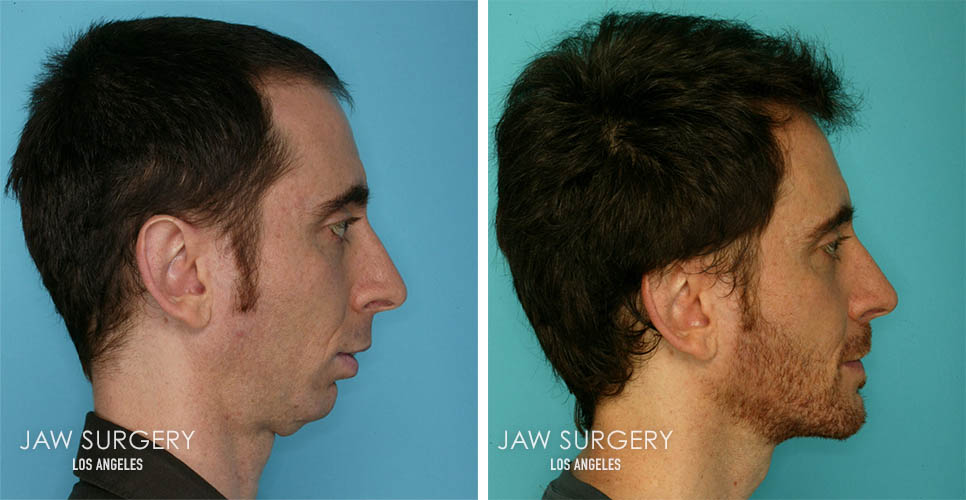
Case Description:
A receding jaw can adversely affect your teeth and health and can result in obstructive sleep apnea, stomatognathic, and TMJ dysfunction.
Treatment time of surgery: 2 hours
Treatment time of distraction osteogenesis: 12 days, turning a proprietary distracter daily.
A short course of orthodontic treatment before and after the procedure was needed.
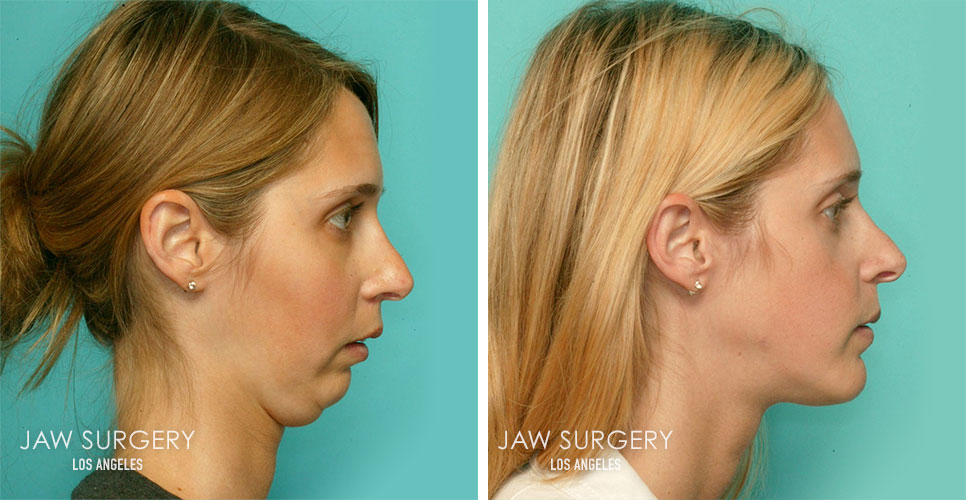
Case Description:
An imbalance of the jaws can significantly adversely affect the health of the teeth, jaws, and overall health. If left untreated, the damage is progressive, especially as one ages and the tissues become more susceptible to breakdown.
This patient chose to correct her jaw imbalance before the damage and deterioration progressed.
Treatment time of surgery: 3 hours
Orthodontic treatment: 6 months prior to surgery and 6 months after surgery due to her severe malocclusion (improper bite).
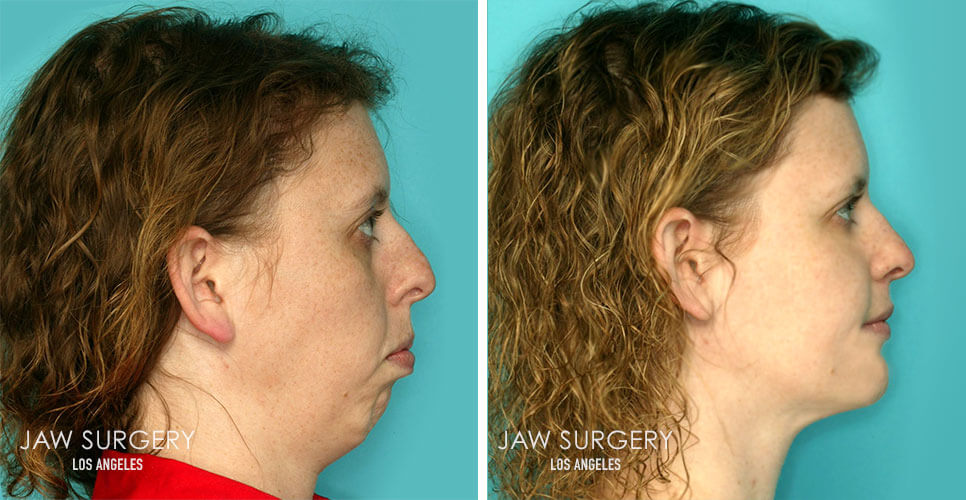
Case Description:
Danielle complained of strain of the lips, jaw pain, and an uncomfortable bite. Her dentist referred her in due to progressive gum recession and clicking and popping in her jaw.
Type of surgery: LeForte I, BSSO and Genioplasty
Duration of Surgery: 4 hours
Duration of orthodontic treatment: 11 months due to her malocclusion (improper bite), headaches and TMJ pain.
Following surgery the strain of her lips and mentalis muscle resolved. She reported her bite felt balanced and comfortable. The clicking and popping of the TMJ resolved and the micro-trauma of the malocclusion and mechanical cause of her gum recession was eliminated.
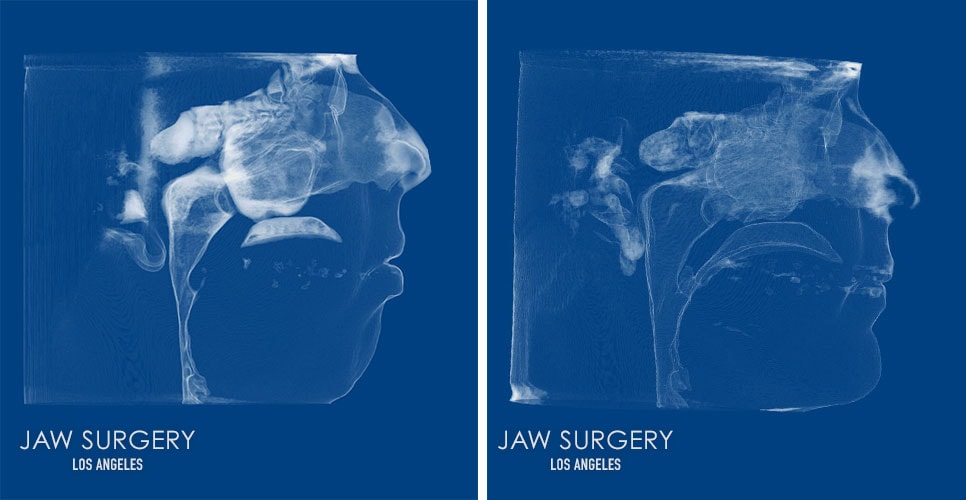
Danielle complained of despondency, depression, and feeling tired when she woke up in the morning after sleeping 7 hours. She felt a lack of energy and by the end of the day felt more tired. She thought that it may be affecting her memory and work.
The imaging taken at Jaw Surgery LA Imaging Center shows a narrow airway before surgery (left image) and a normal airway after surgery (right image).
Following treatment all of her symptoms resolved and she reported “a tremendous feeling of well being, energy and overall quality of life and happiness.”
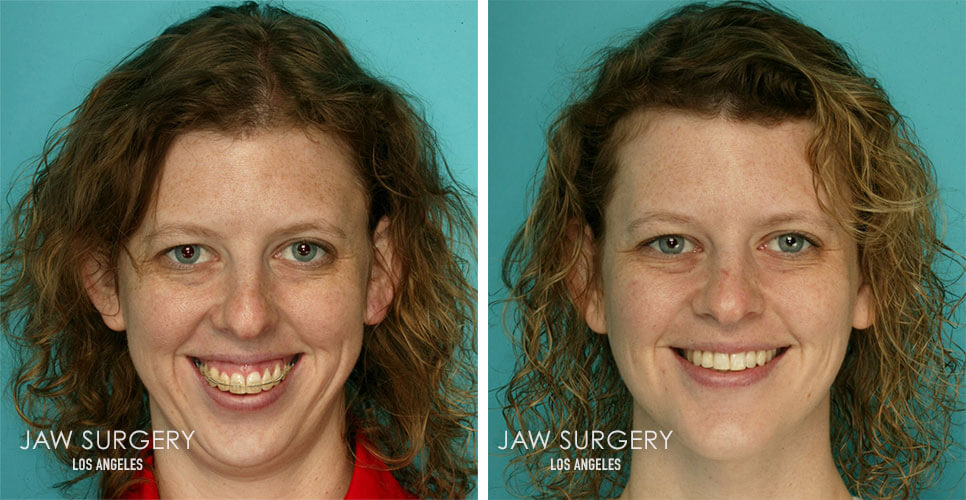
Danielle also complained of a “gummy smile” that she said bothered her and made her feel “very self conscious” every time she smiled.
The maxillary impaction procedure and orthodontic treatment eliminated the “gummy smile” and restored a natural facial and muscle balance.
Treatment included palliative modalities and careful placement of the TMJ condyles into the physiologic centric position Rx by Dr. Jacobson, with complete resolution of her pain and dysfunction.
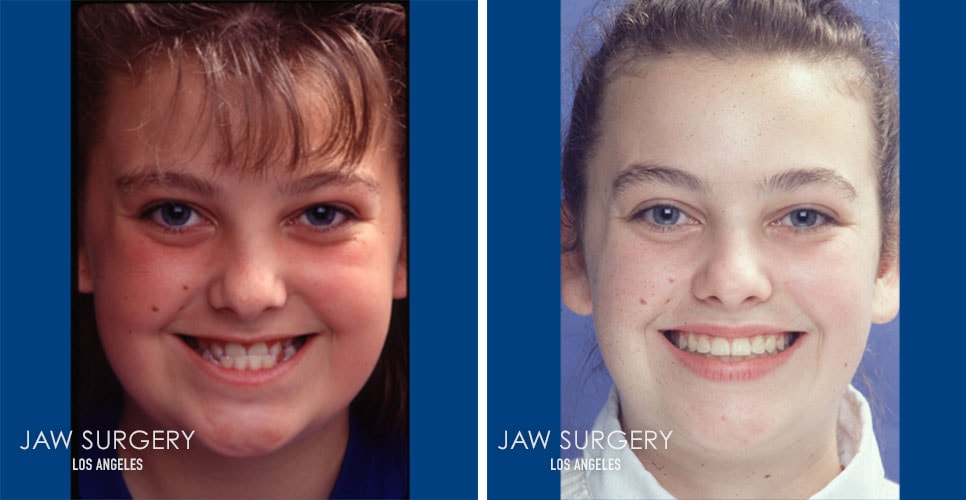
Case Description:
Stephanie complained of an uncomfortable underbite and a smile that bothered her. Her teeth were wearing down but her mother intercepted and brought her to our Orthodontic Center LA at an early enough age. As a result a jaw surgery was 100% prevented.
All treatment was completed by Dr. Jacobson using a segmental technique and interceptive orthopedics taught to him by his mentors Dr. Ricketts and Dr. Tom Graber, after completing his specialty training at UCLA. Since then Dr. Jacobson has developed a series of additional effective techniques and protocols, for children and young adults to intercept and correct mild and moderate skeletal and dental malocclusions, without the need to do jaw surgery.
Before orthodontic treatment (left image) and after orthodontic treatment (right image). No jaw surgery was needed.
All children should be checked by a board certified orthodontist with extensive experience in cephalometrics and growth and development.
Most malocclusions (improper bites) can be improved if intercepted early, preferably before the permanent teeth erupt (come into the mouth). Early treatment can also significantly reduce the total active treatment time and enhance stability.
Most growth of the jaws is complete by age 15 years in a young woman and age 21 in a young man. After those ages, there are advanced orthodontic treatments that can be used to treat significant imbalances of the jaw and bite, but jaw surgery can usually produce a much better result.
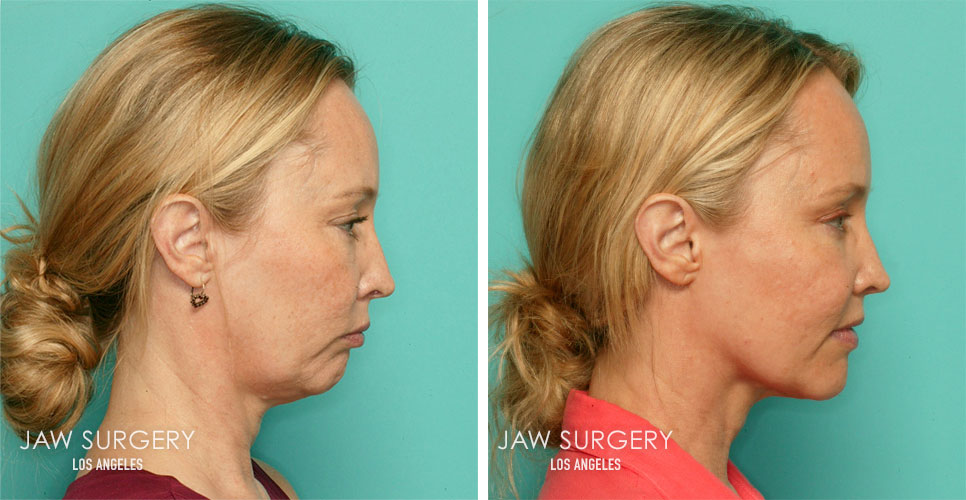
Case Description:
This patient complained of an asymmetry and uncomfortable bite with pain in both TMJ’s. If the jaw is anatomically asymmetric and disparate, jaw surgery can restore balance and symmetry.
Before surgery (left image) showing the strain of the lips and muscles contributing to the TMJ pain and imbalance. After surgery (right image) showing the surgical correction of the skeletal imbalance.
After surgery, bite adjustments and specially constructed TMJ splints can be used at night as retainers and protectors for patients that habitually clench or grind their teeth at night.
Ancilliary dental and restorative procedures are best done after the surgery is completed to refine the anatomy of any worn down teeth and to improve overall smile esthetics if patients want to enhance the size, shape, color or contours of their teeth.
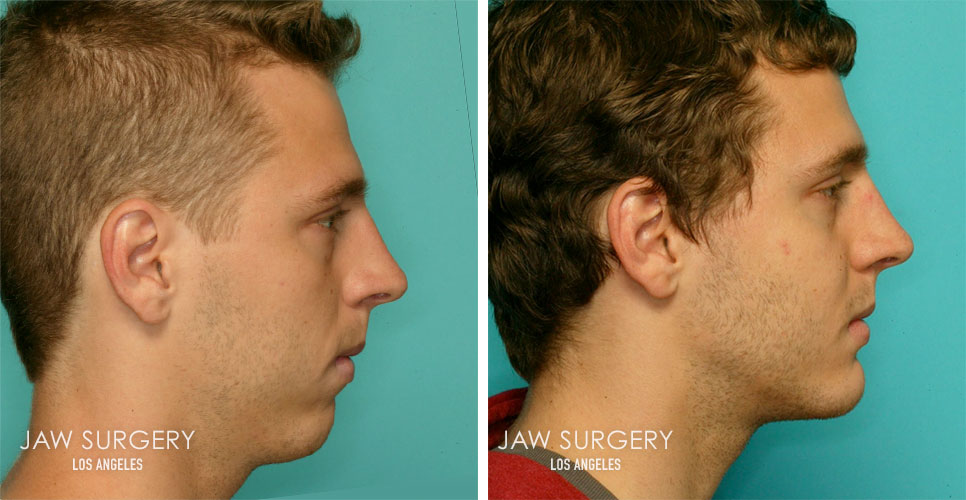
Case Description:
Left image: Before a genioplasty (chin surgery).
Right image: After genioplasty (chin surgery).
Notice the normalization of the lip strain on the upper and lower lip after orthodontics and chin surgery. No upper jaw or lower jaw surgery was needed, only chin surgery.
A prosthetic chin implant typically performed by a plastic surgeon without maxillo-facial specialty training is NOT preferred for this procedure. A genioplasty (chin surgery) can be adjusted to decrease the lower facial height and the bone remodels.
A surgeon that is double board certified in Maxillo-facial and Plastic Surgery is preferred due to the subtleties involved in the management of the soft and hard tissues of the chin.
Before surgery this patient complained of an uncomfortable bite with lip and muscle strain. He had difficulty closing his lips and complained of a mouth breathing habit especially while sleeping with dry mouth and bad breath upon waking.
Dr. Jacobson used TAD’s (temporary anchorage devices) for 5 months in conjunction with orthodontic treatment to reduce his severe open bite, non surgically. Then the chin surgery was completed to help restore facial balance and alleviate lip strain.
The chin surgery was completed in 1 hour under general anesthesia. The surgery was performed at our Jaw Surgery LA on site AAAHC certified Operating Room on a Friday. He recovered at home over the week-end and returned to visit us on Monday.
Typically the bruising and swelling from a genioplasty (chin surgery) procedure resolves within one to two weeks and no wiring of the jaws or elastics is needed.
Orthodontic treatment total time was 10 months to correct his severe open bite. TAD’s were only needed for 5 of the 10 months.
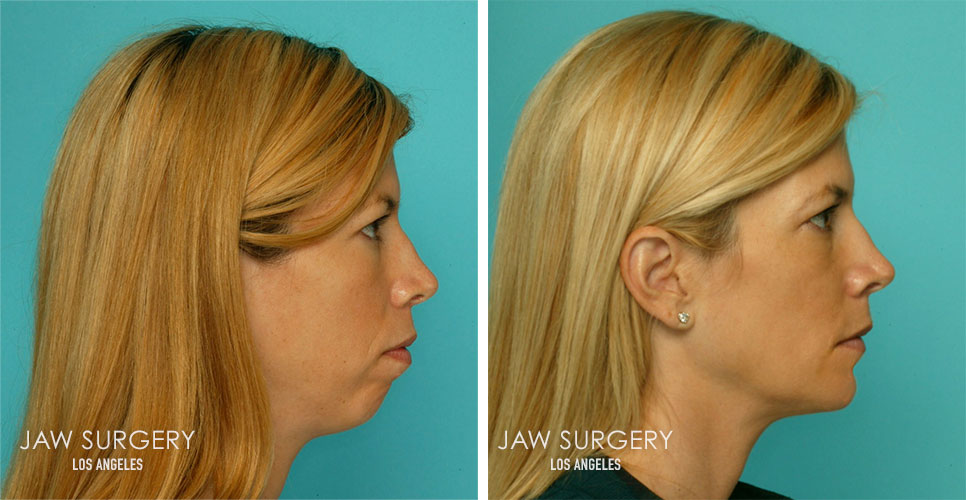
Case Description:
This patient visited Jaw Surgery Los Angles complaining of an uncomfortable bite and an inability to close her lips. She wanted to also improve her facial esthetics and profile. Her dentist told her she showed evidence of clenching or grinding her teeth, likely at night and she reported mild soreness in the muscles of the face.
The treatment included orthodontic treatment in conjunction with orthognathic surgery to help restore facial balance, and harmony. Post-treatment, she reports a very comfortable bite with no muscle tension. Her goals are to maintain a health bite and teeth for life without the need for extensive future dentistry.
There is seldom any need to ‘wire the jaws shut’ following surgeries performed at Jaw Surgery LA due to the orthodontic and surgical protocols followed for the past 20 years. All surgical incisions are made inside the mouth so there are no external of visible scars.
It is possible to prevent surgery on many patients before they have completed their growth. Men typically complete most of their growth of the jaws and face by age 21. Woman typically complete most of their facial and jaw growth by age 15.
All three children of this patient completed interceptive orthodontic at our Orthodontic Center LA and have not needed jaw surgery.
There are many advantages to diagnosing and intercepting malocclusions early, even before the permanent teeth erupt. Many times surgery can be prevented, and the overall extend of treatment is often much less with better short and long term stability.
Attachments area
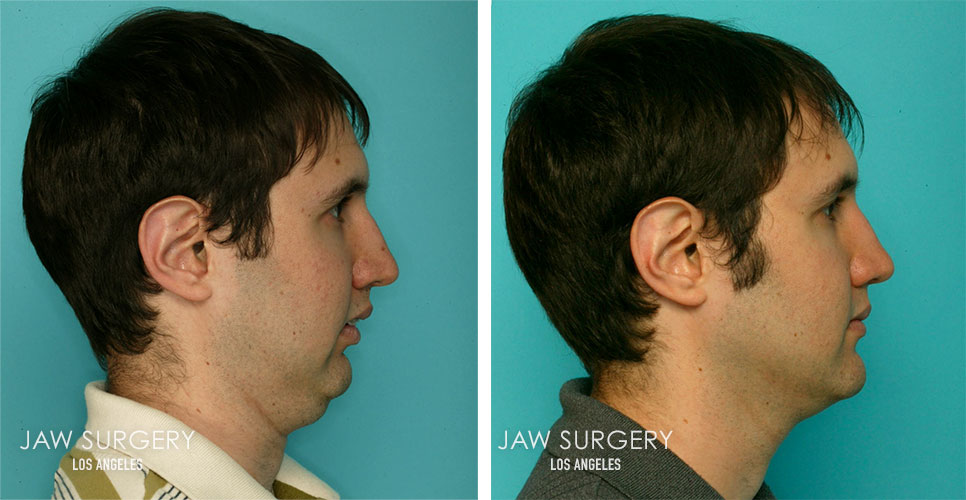
Case Description:
This patient is highly intelligent, decisive and discerning. He wanted to correct his overbite to help protect his teeth from unnecessary damage from day to day chewing, biting and eating.
The treatment including a short course of orthodontics due to his malocclusion, in conjunction with jaw surgery at Jaw Surgery Los Angeles.
He is very happy with the overall improvements. He reported that most people he knew did not even realize that he had had any treatment or changes. He said that either people are not observant or the changes were subtle enough to go unnoticed. He himself fully enjoys this positive change.
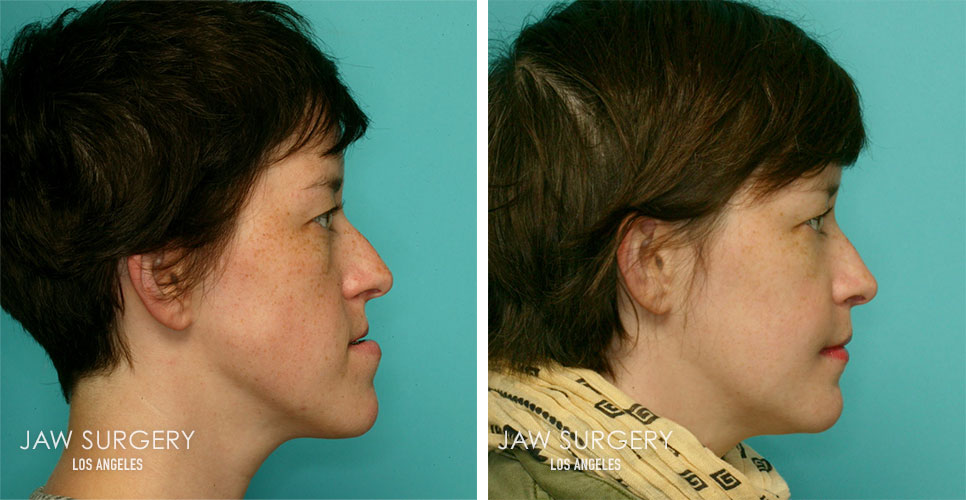
Case Description:
This patient was referred to Jaw Surgery Los Angeles concerned that her teeth were wearing down unnecessarily. She commented that she is generally a happy person, but was incorrectly perceived as looking stern.
Her bite and jaw were uncomfortable and she was told that she snored while sleeping. Disparate jaw positions can adversely impact one’s airway and cause unnecessary snoring. Besides being annoying, and disruptive to quality sleep, snoring can prevent optimal oxygen intake and saturation during sleeping. This will in turn, regressively impact overall health and well-being.
Orthodontics in conjunction with jaw surgery can resolve obstructive sleep apnea and restore a more natural facial balance along with a bite correction. Changes can be rewarding in terms of general health in addition to the health of the teeth, bite, TMJ’s and facial musculature.
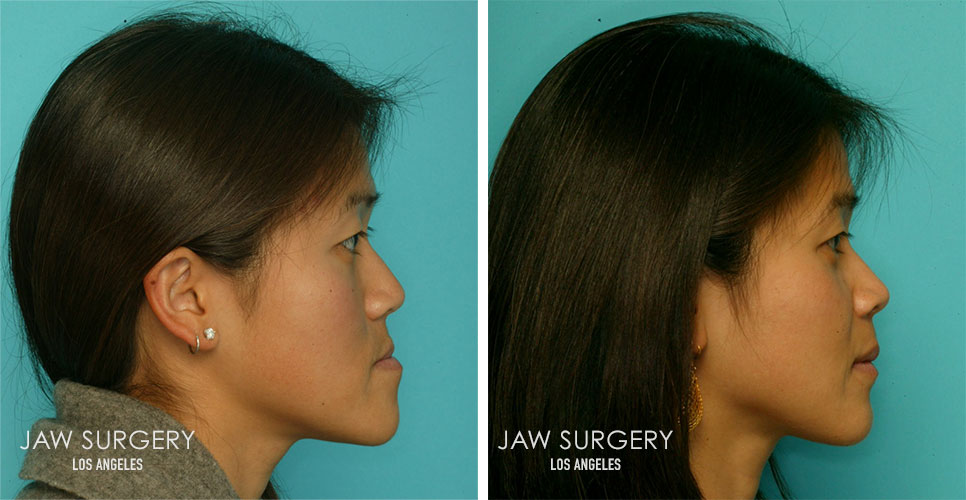
Case Description:
This patient flew in from Northern California, concerned about an underbite and a lack of teeth showing during smiling. She also had clicking and popping of the jaws, intermittent headaches, and an uncomfortable bite with lip strain.
The treatment and surgical correction of all malocclusions, especially malocclusions of the skeletal type, is complex.
The class 3 type malocclusion with an underbite is particularly complex. In a class 3 type malocclusion, the correction of the skeletal disparity must include a very careful analysis of the TMJ, airway, teeth, bite, soft tissues, and the extent of skeletal, facial, and muscular imbalance.
There is no such thing as a simple skeletal imbalance and the protocols established at Jaw Surgery Los Angeles adhere to for all types of skeletal and dental anomalies.
Optimal treatment does not always involve simply setting the lower jaw back in a Skeletal Class 3.
Paramount, is the pre-surgical stage of positioning of the teeth, into a position that facilitates optimal jaw surgery placement.
Patients want to look and feel good and want a result that can last a life-time.
Dentists and orthodontists want a bite that is a class one with the TMJ condyles centered into a physiologic centric position that is repeatable, very comfortable and mutually protected with immediate disclusion in protrusive function and all excursions.
ENT’s want to ensure there is an exceptionally good airway with no blockage in the nose or sinus congestion.
Speech pathologist and myofunctional therapists want to make certain the tongue has enough space in the mouth for best swallowing and speech.
Sleep specialists want the jaws positioned in a way to allow the air to flow optimally, including at the back of the mouth (retro-glossal and retro-palatally), with no excess soft tissue or uvula laxity or tissue excess that vibrates, causing snoring during sleeping.
Chiropractors, osteopaths, and physical therapists want to make certain the muscles of the face and neck are relaxed and not strained.
Everyone wants natural-looking smile. That is a lot to strive for.
Patients prefer not to have braces (orthodontic appliances) on their teeth. If needed, they prefer them for as little time as possible.
Fortunately, digital technology and protocols developed at Jaw Surgery LA allow us to significantly decrease the time of the pre-surgical preparation and the need for braces before and after surgery.
3-D imaging, intra-oral scanners and proprietary software also help us improve accuracy and decrease overall treatment times.
A comprehensive pre-surgical virtual protocol and resultant custom individualized jigs used during surgery also helps reduce the actual time of surgery. Shorter surgery times and well-integrated post-surgical protocols can help facilitate a much shorter and easier recovery.
All surgeries are rehearsed digitally prior to the actual surgery so patients and specialist can collaborate visually to better understand and appreciate the options, alternatives, and limitations inherent.
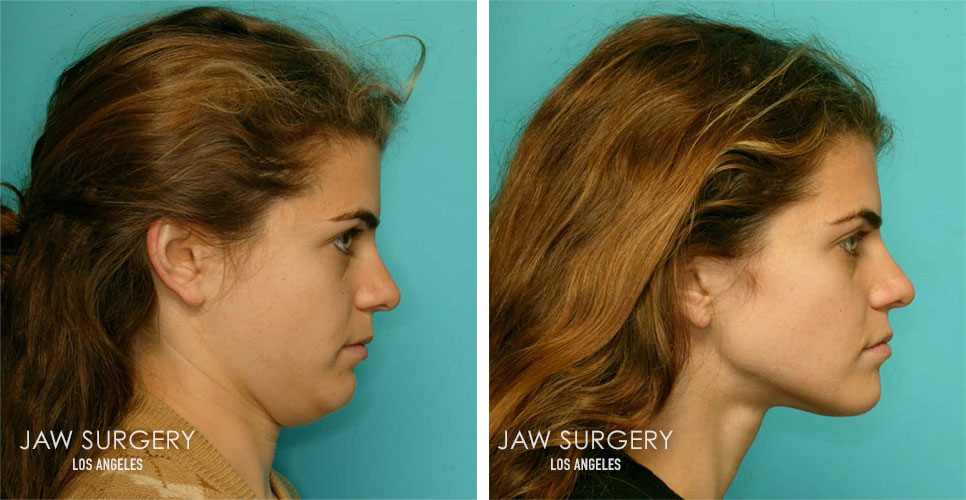
Case Description:
Chief complaint: Jaw pain, headache, facial pain and clicking of the TMJ with an overbite.
Procedure: Surgical movement of the lower jaw forward (Bilateral Sagittal Split Osteotomy)
Duration of Surgery: One hour
Orthodontic treatment specific for jaw surgery: 8 weeks
A protocol developed at Orthodontic Center LA and Jaw Surgery Los Angeles was followed.
One important part of this treatment was to establish the optimal position of the temporomandibular joint, specific for this patients’ structure and function.
Dentists, orthodontists, and surgeons are taught and typically use a TMJ position called Centric Relation (CR). There is much controversy regarding this position within the profession. CR is generally appropriate for most patients that are not in pain or do not have dysfunction.
This CR position was not used for this patient due to her ‘slipped disc’ (meniscus displacement) and loose TMJ ligaments (joint laxity).
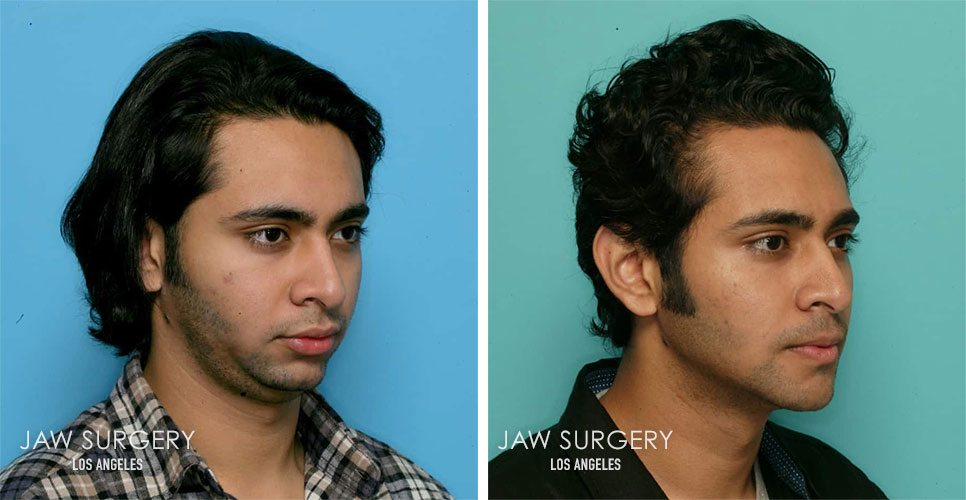
Case Description:
Chief complaint: I am an actor living in India and just got an offer to do a very big movie with Netflix and I want to correct my overbite and create a more defined jaw.
I was referred to Jaw Surgery Los Angeles from one of the reputedly “best specialists world-wide” who said that the Jaw Surgery Los Angeles specialists are the best for this type of jaw surgery and worth flying to Los Angeles for.
“I am soooo happy with the results, was offered a leading role by Netflix and can’t thank you enough”.
This patient was specific about what he describes as a “Brad Pitt” jaw and brought us numerous photographs of what he liked.
We spend a considerable amount of time with him and his family, who flew to Los Angeles for the consultations. We were able to achieve the look and definition he wanted.
The surgery duration was 90 minutes, performed at our onsite AAAHC OR under general anesthesia on a Friday. The patient spend one night at a near overnight recovery center and returned for followup checkups on the following Monday. He described his total recovery as “surprisingly easy and fast” compared to what he had seen on the internet.
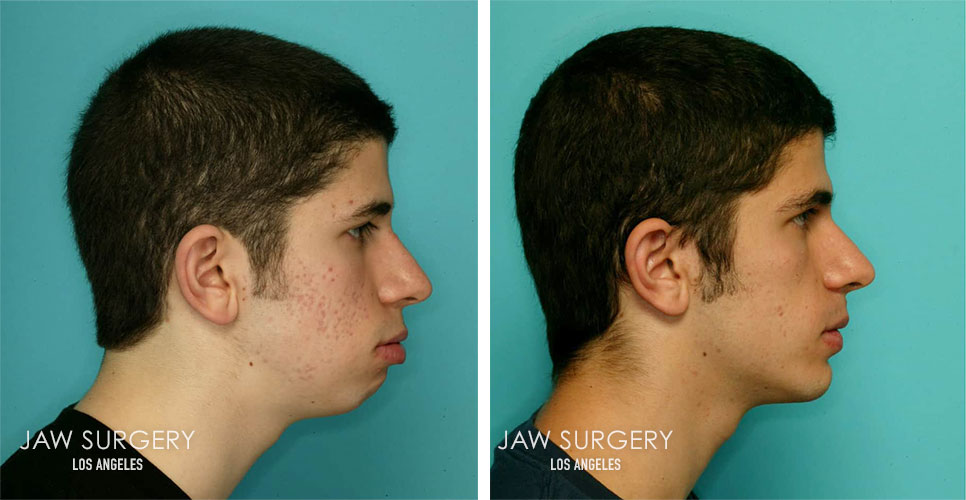
Case Description:
Chief complaint: “I am insecure and self conscious about my weak chin and tried to “get over it” but am struggling.
Surgical procedure: Wedge advancing genioplasty.
Duration of surgery: 1 hour (No external scarring, since all incisions are inside the mouth in the vestibule below the lower lip).
Orthodontic treatment needed: None specifically for a genioplasty.
Many times tooth movement is planned to ensure a Class I or an optimal bite and best placement of the teeth, for best functional and facial results.
A Genioplasty is not an implant.
Most plastic surgeons offer patients chin implants but a chin implant can resorb into the bone over time. Chin implants offered by Plastic Surgeons tend to look like an ‘add on’ and not natural, especially when the lower jaw and chin appear recessive like in the images above.
Specialists at Jaw Surgery Los Angles are board certified in Plastic Surgery but also board certified in Maxillofacial Surgery. The genioplasty procedure is carefully planned using 3-D imaging of the hard and soft tissues to help ensure the optimal placement of the chin.
The face is so delicate and small changes can make a very big difference.
Proprietary software and hardware allows surgeons to plan changes in size, shape, contour, position and symmetry.
Chins can be canted, protrusive, recessive, too long vertically, too short or asymmetric.
There is a lot of subtlety to chin surgery and it is best planned and performed by an experienced surgeon with dual board certification and training in both Maxillofacial and Plastic Surgery.
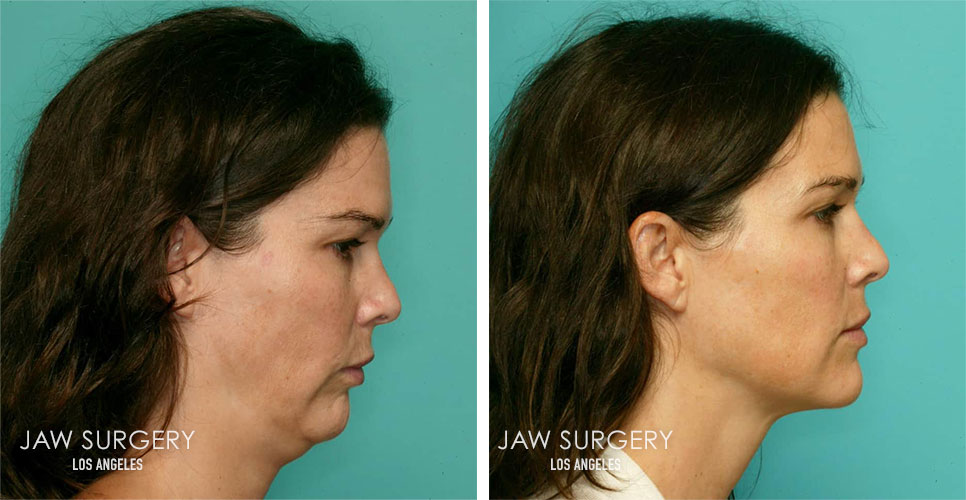
Case Description:
Chief complaint: “I had braces and lately my face is changing and sagging a little and it makes me look tired and old, but I am not tired and I feel young. I was referred to your Orthodontic Center by so many people that are very happy with their results and Dr. Jacobson recommends that I do jaw surgery for the best results for my condition”.
Surgery duration: 90 minutes under general anesthesia.
This patient said that she kept cold packs on and off her jaw, intermittently for the first 24 hours after surgery. She said she slept with her head slightly elevated for two nights following surgery. She reported very little swelling and a fast recovery with very little discomfort, even though she stopped taking pain medication days after her surgery.
All patients will experience swelling, especially the day after the surgery but protocols and recommendations developed at Jaw Surgery Los Angeles help significantly accelerate recovery.
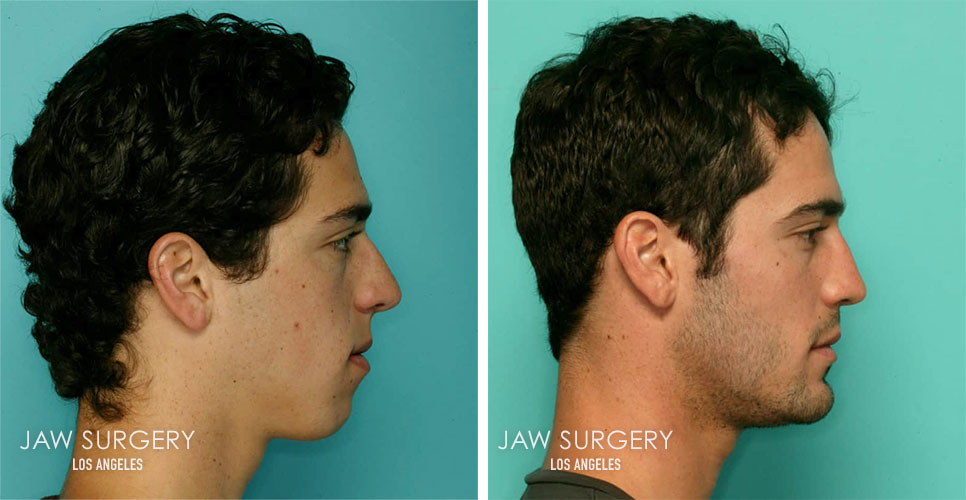
Case Description:
“So many people I know that are really happy with their orthodontic treatment had their braces and Invisalign done at Orthodontic Center LA in Pacific Palisades”.
“I was referred to Jaw Surgery Los Angeles by Dr. Jacobson at Orthodontic Center LA, who said my chief complaint of a longer looking face and a slightly weak chin cannot be corrected by orthodontics alone but that combined with jaw surgery, I could get the result I was looking for”.
“I did not really want to change the way I looked, just improve my weak chin and be able to close my mouth better”.
“I love the results”.
“Friends that have not seen me for a while, say I look strong and healthy, like I have been working out. They have no idea that I had jaw surgery. I tell them and they say I look fantastic, but that they would never have been able to tell”.
“It is subtle but I love the change. When you see the before and after, it is an amazing result, even better than what I could have imagined.”
Duration of surgery: 3 hours under general anesthesia
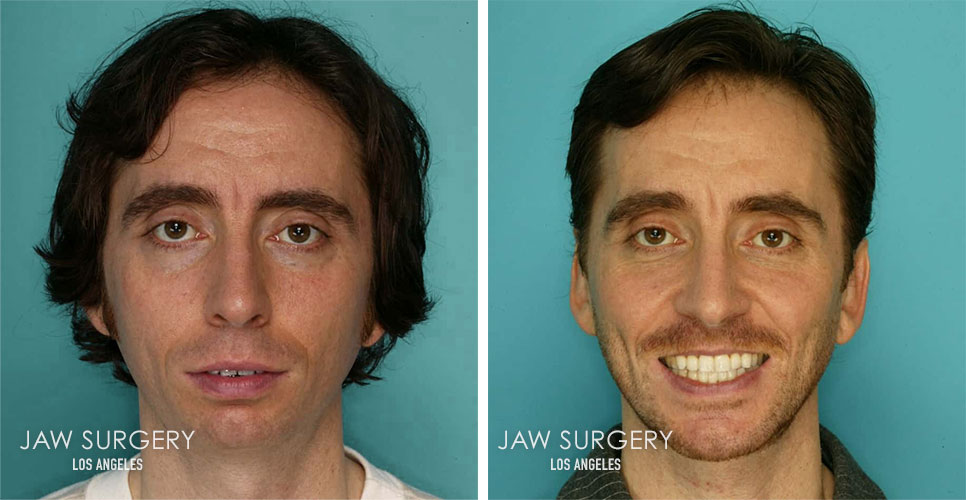
Case Description:
Chief complaint: “I’ve always had an uncomfortable bite and jaw. I was very self-conscious growing up. I felt I looked ‘goofy’. Now my teeth are wearing, my gums are receding and my face is changing. It seems like this is slowly getting worse.”
Surgical procedure: Distraction osteogenesis of the mandible in conjunction with orthodontics.
Distraction, using curvy-linear distractors designed by Dr. Schendel, Professor Emeritus and founder of Jaw Surgery Los Angeles, allows directional distraction and optimal control in the forward, side to side and up and down direction. Dr. Schendel recruited Dr. David Dorfman DDS MD to succeed him as Chief of Surgery at Jaw Surgery Los Angeles.
Carefully controlled, distraction can enhance the vertical facial height as well as the overbite. Distraction also correct asymmetry. Advancing a lower jaw that is severely recessive with conventional jaw surgery is insufficient to fully correct severe jaw deformities. Distraction surgery allows a better result in these cases.
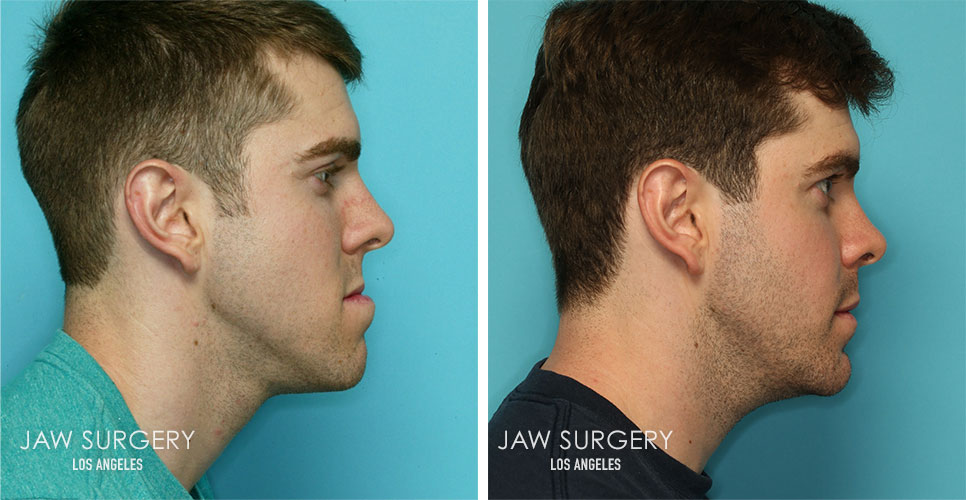
Case Description:
This patient complained that his bite was uncomfortable and that he did not like the way he looked, including what he described as a protruding lower jaw. He also complained of tension in the face and neck and headaches.
His dentist was concerned because his bite was causing damage to his teeth and bone and he was warned that this would be progressive and he would lose his front teeth due to resorption and loss of bone around the lower from teeth.
He was concerned especially how young he was, that further damage could occur. He anticipated needing implants, instead of his lower front teeth.
Treatment
A short course of treatment with orthodontic appliances was designed to prepare for the jaw surgery. Jaw surgery duration was 3 hours, no wiring shut, no overnight stay in hospital, and all incisions done inside the mouth, so no facial scars.
Four days after surgery, he visited us, really pleased with the results. When the braces were removed, a lingual retainer was placed on the lower front teeth to hold them in position so he did not have to wear a retainer, and also to protect them from the loss of bone that occurred prior to finding us.
It is important when doing surgery like this, to make certain that the patient’s chief complaints are considered but in addition to make certain that the jaws are positioned for optimal long term health and function and airway and for optimal oxygen saturation during sleeping. (Moving a lower jaw back, can cause OSA. Moving the jaws correctly, can prevent OSA)
Function and form are intimately related. Optimal esthetics, function and long term health are all vitally important.
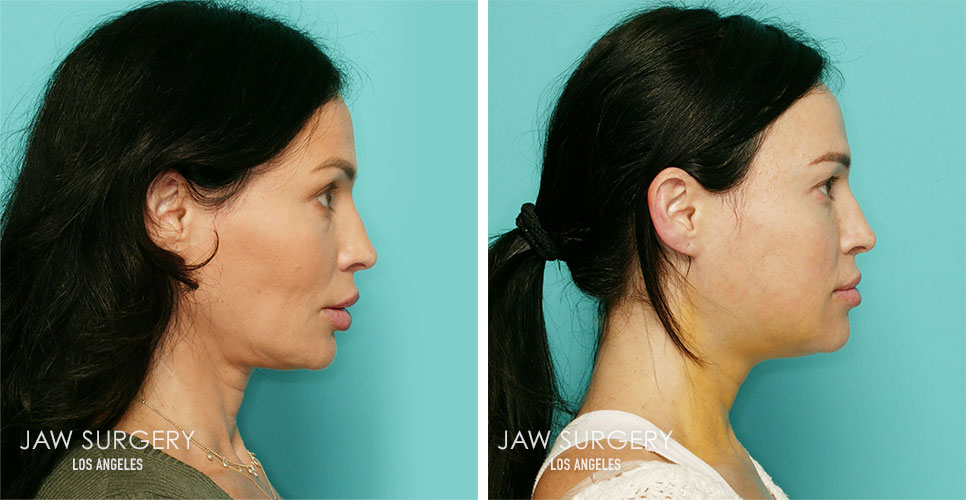
Case Description:
This patient complained that her face was changing as she was getting older and she thought she needed a neck lift and face lift.
Her dentist told her to visit Jaw Surgery Los Angeles instead. (www.jawsurgerylosangeles.com)
He said it was her lower jaw that was incorrectly positioned causing the facial changes and that plastic surgery would give her a “fake and plastic skin pulled back look”.
He told her that even with extensive plastic surgery the source of her problem would not be addressed.
Her dentist also noticed her teeth wearing down and her deep bite.
Treatment
The treatment time was 1.5 hours. All the incisions were inside the mouth, with no wiring shut and no hospital stay, (out patient), performed in our AAAHC on site OR
Here she is seen 4 days after her surgery, showing a very small amount of swelling and bruising with full correction of her deep bite and no need to do any plastic surgery whatsoever.
Her swelling and bruising resolved fully with no one even knowing she had jaw surgery 10 days after her procedure. (Individual swelling and recovery vary, based upon the age and health patient’s and the skill and management of the team of surgeons.)
For patients needing of wanting plastic surgery, the chief surgeon at Jaw Surgery Los Angeles is a fully board certified Plastic Surgeon (and dual board certified in Maxillo-facial and Craniofacial surgery).
The amount and extend of plastic surgery can be greatly reduced by positioning the skeletal structured correctly. When needed, judicious plastic surgery procedures can be included, and the chief surgeon’s soft tissue management is magnificent.
She loved her results and was vociferous in her gratitude. She was on exceptionally good terms with her ex husband and referred him in for treatment also. He also was very happy with his results, but only needed orthodontic treatment and not orthognathic surgery.
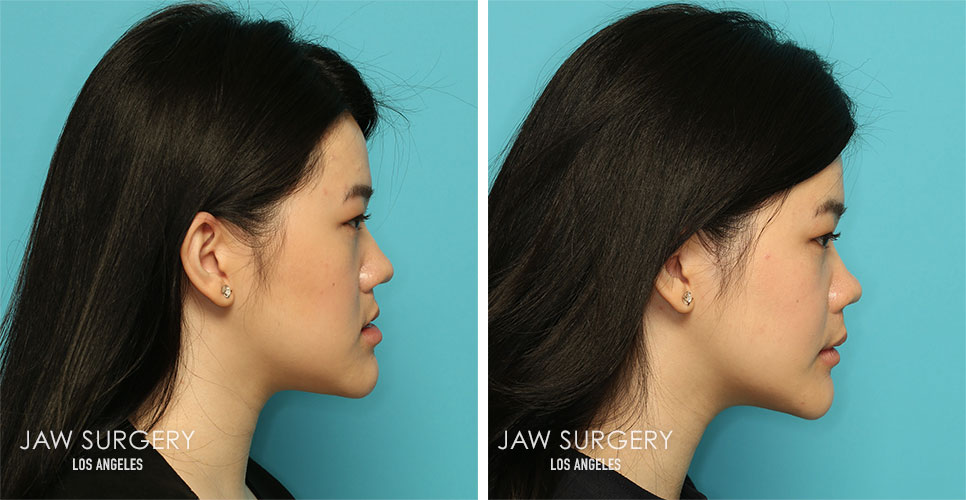
Case Description:
This young lady lives in Indonesia and was referred to Jaw Surgery Los Angeles complaining of an uncomfortable bite. She was particularly unhappy about her profile esthetically and her strong, what she called “masculine chin and harsh appearance. She also had and underbite and her teeth were wearing down, even at her young age of 17 years.
We spend a lot of time discussing her concerns, including that she and her family did not want to change her face or looks. She only wanted a subtle change from her “masculine looking jaw”, while still correcting her underbite.
Treatment with Jaw Surgery
The jaw surgery was completed in the onsite AAAHC OR in 3 hours, with all incisions inside the mouth and no ‘wiring shut’ of the jaws.
She went home immediately after surgery and returned for her post op visit a few days later, with very little swelling and reported going off her pain medication within a few days.
Fortunately, pain is relatively easy to control in this day and age, though patients’ requests for pain medication varies, based upon their age, health and disposition. We recommend taking pain medication, irrespective, for at least a few days following surgery since staying ahead of the pain is preferable. Most patients can progress to over the counter medication within a few days, for a few days, as needed.
She and her family was so thrilled with her results and with the whole process, from start to finish. Her family send us flowers and a beautifully decorated cake with warm words of thanks for taking such good care of their precious daughter.
She returned to our center a year later from Indonesia, with little gifts for our team, and to show us her magnificent results, reporting wearing clear retainers, every alternate night.
Our entire team really enjoys the relationships we develop, with concierge personalized care. Everything we do, aside from the technical multi-disciplinary expertise, is to make the entire process safe, warm and congenial.
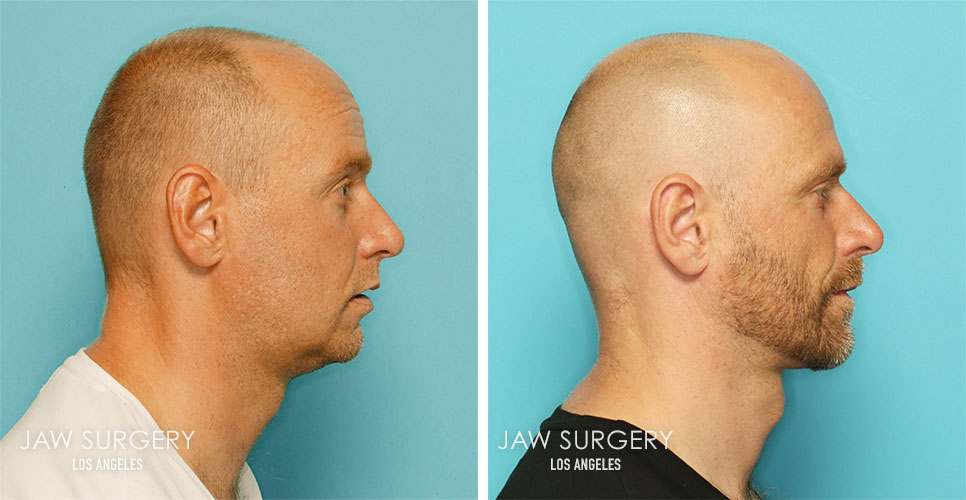
Case Description:
This highly successful entrepreneur’s chief complaint was what he described as an uncomfortable bite and “weak chin”. He did not want to wear braces that were visible and wanted to begin and complete the surgery in a very short period of time. He also did not want to change his facial appearance and preferred that no-one would notice the changes.
Treatment
The jaw surgery performed was a bilateral sagittal split osteotomy that took 2 hours to complete and his recovery was rapid with results that he loves.
We completed a study of 1300 of our patients evaluating their airway and the retro-glossal area using our CBCT records and found that the airway tends to get progressively smaller as we age, after the age of 30 years. This can cause and contribute to snoring and obstructive sleep apnea (OSA) with progressively worsening health, including feelings of depression, despondency, despair, cognitive impairment, memory loss, diabetes, heart disease and a litany of regressive health disorders. Fortunately this man did not suffer from any of these. This type of surgery is designed to help prevent OSA. In cases of moderate or severe OSA, an MMA is often RX.
Orthognathic surgery, done correctly with an emphasis on, not only the teeth, bite, TMJ, facial and smile esthetics, but also on the airway, can resolve and help prevent OSA when corrected optimally.
Every individual will be evaluated and a treatment plan formulated specifically for you, since there are multiple variables responsible for optimal results and everyone is uniquely different.
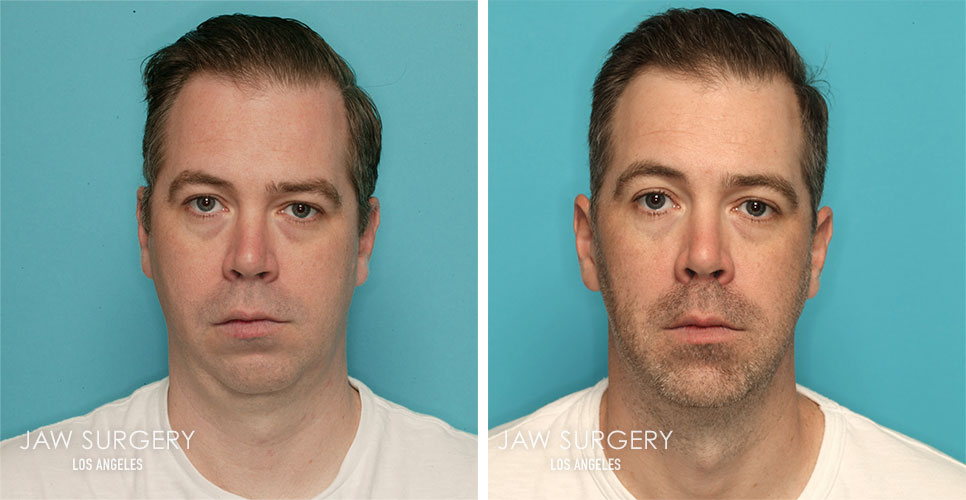
Case Description:
This successful entrepreneur noticed that his face was asymmetrical and he complained that it seemed to be getting worse. He had been treated with braces previously but his bite was not able to be corrected without jaw surgery. His dentist was concerned that his teeth were wearing down and that it could lead to gum recession and bone loss. He also noticed clicking in the TMJ’s and wanted to address all these issues so they did not regress.
His dentist said to him that he did not want him to be sitting in his office in his latter years of life needing extensive and expensive prothetic dentistry, that would require compromise since his jaws were “mismatched”.
The Jaw surgery duration was 4 hours. All incisions were inside the mouth so no visible scarring and no wiring shut.
James visited our office 4 days after surgery and his post op recovery was fast. He was asked to remain on a ” no chew diet” for 21 day but could eat anything as long as it was blended. After 3 weeks a normal diet is encouraged, beginning with softer foods for a few weeks.
James was so pleased with his results that he brought his young son in for an evaluation to see if we could help prevent his son ever needing jaw surgery.
Prevention of Jaw Surgery in Children
If children are evaluated early, before the permanent teeth erupt, age 6 or 7 years, many malocclusions can be prevented, intercepted, or treated, usually in a shorter time and with better stability.
Even severe skeletal disparities, if caught early, can be treatment planned accordingly, even if jaw surgery will be needed at maturity, making the jaw surgery process and preparation even easier.
Men and woman should not proceed with jaw surgery until their jaws have matured.
Most men are fully mature in the growth of their jaws by age 19-23 years. Most woman are fully mature in the growth of their jaws after age 15 years. There is no upper age limit as to when jaw surgery can be done however the younger you are, the quicker the recovery process, in general.
